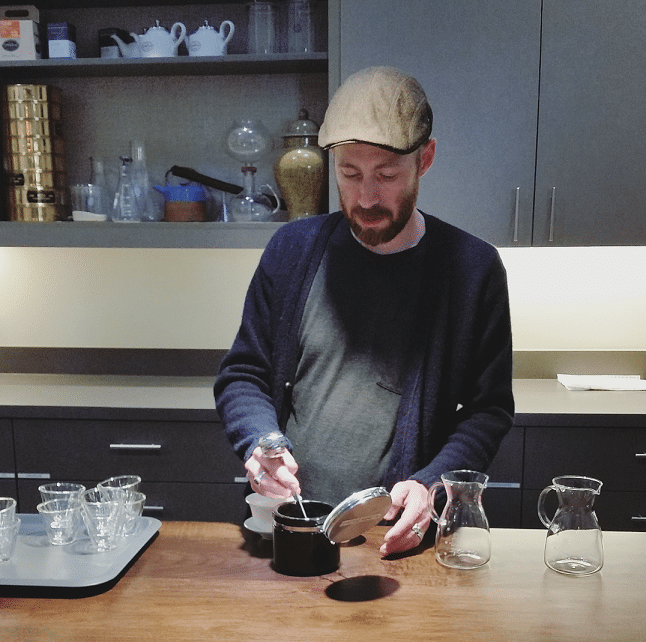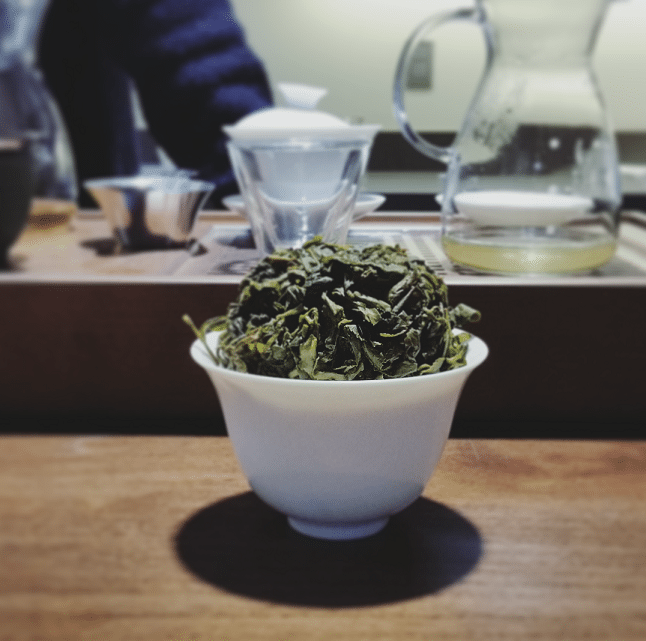Back in 2009, I didn’t like oolongs. In general, anyway. There were some specific ones I liked, but most of them were off limits. I even explained this to Tony Tellin, lead blender extraordinaire at Smith Teamaker, when he was working the tea bar one day.
He said, “You’re probably not brewing them right.”
He escaped into the back and brought out a gaiwan (lidded Chinese teacup), and then he gave me a quick primer on how to do gongfu cha (literally, “brew tea with skill”). I had seen it done before, but it always intimidated me—multiple steeps, multiple pours, and the equipment required. He assured me that all I would need was a gaiwan, and to remember, “Short, successive steeps”.
Then he gave me his gaiwan.

It’s . . . seen a lot of use. By me.
The li’l sucker even had the branding from Tony’s former employer/overlords.

While it is “well-seasoned”, now, I still use it for regular brewing, particularly for cooked puerh. In fact, one could even say that it is one of the most important brewing vessels in my fledgling collection. The whole ritual of gongfu brewing is my default these days. So, when I received a message that Smith was finally introducing a gongfu service at their two brick-‘n-mortar locations, and that Tony would be presiding over a couple of demos for press people, I felt obligated to go. After all, if it weren’t for him, I wouldn’t be the “gongfool” I am today.
There were two press demos that were scheduled. The only one I could attend was their Wednesday session. It was a smaller gathering, and they moved it to their “lab”. (Yes, they have a lab. It’s awesome.)
They provided an example of what their gongfu set-up would look like for customers. The intended set-up provided a tray, a gaiwan, the displayed tea leaves (with info card), a small pouring vessel, two transparent serving cups, and a thermos of heat-insulated water for future steeps. It was very streamlined compared to most retail gongfu services, which sort of matched the overall Smith aesthetic. That being, “Make it as approachable as possible”.

Tony broke out the new oolong they added to their roster for the demo—their No. 80 Ali Shan Oolong. It was a very buttery offering from my favorite Taiwanese mountain. And, from there, he went about showing all of us how to brew.

One of the things he highlighted was the amount of leaves to use. Typical gongfu prep called for 6 – 8 grams of leaves per gaiwan helping, roughly a tablespoon of ball-fisted oolong leaves. While this was (mostly) standard, it was also an approach that was open to some subjectivity. Case in point, I often used only a teaspoon worth of leaves. I got all of the flavor punch, but not an overabundance of it. However, in this case, it worked to the Ali Shan (and the drinker’s) benefit. The more leaves used, the more butter the drinker tasted.
And by the end of the whole affair, there was quite a ball o’ oolong on display.

Blender Tony also demonstrated gongfu with their Bai Hao Oolong; a personal favorite of mine. Not sure why, but bug-bitten oolongs were becoming my default flavor preference. Must me my sweet tooth; I should probably get that checked.
At the end of the session, the Smith staff gifted us with a bag of oolong of our choice, as well as a couple of seasonal blends that were set for release. They also promised us our very own gaiwan to take home. As Tony got around to me, though, he asked, “Wait . . . how many gaiwans do you have already?”
I had to count. “Four? I think?”
“Oh, you don’t need one,” he said, but then continued, “but I have something else you might like.”
He disappeared in the back for a moment, and came back with a wicker-bound . . . thing. No other way I could describe it.

“I picked this up in Nagaland,” he told me. “While not intended for this purpose, it’s perfect for stacking gaiwans.”
I “squee!”-ed a little.
In closing, while I’m no longer a stranger to gongfu cha—and have since altered it to fit my gongfoolish needs—it was nice returning to where it all began. As Tony Tellin himself said, “I’m not really a fan of tea ceremonies, but this approach works for me.”

And that’s a tea philosophy I adhere to as well.
If you have an approach that works for you, that’s great. But take it from me; a gaiwan will make it even better. No skill required.

Xavier
Some insights about you and your tea philosophy are always appreciated.
I really like your philosophy and your “you can do it every way you want but gaiwan is still the best one”.
lazyliteratus
Can’t deny the truth.